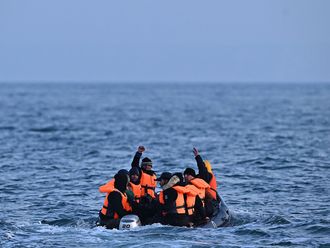
ZAPORIZHZHIA, Ukraine: Scores of civilians, many of them women and children, remained trapped on Thursday in underground bunkers at a steel works, the last Ukrainian holdout in the devastated city of Mariupol, but Russia promised a new lull in fighting to allow them to leave.
Ukraine’s dogged resistance at the vast Azovstal plant has underscored Russia’s failure to capture major cities during a 10-week war that has united Western powers in arming Kyiv and punishing Moscow with sanctions.
In what would be a major historic shift sure to infuriate Moscow, Sweden and Finland may shortly decide to join NATO.
Russia’s military promised to pause its activity in Azovstal during Thursday daytime and the following two days to allow civilians to leave, after what Ukrainian fighters described as “bloody battles” prevented evacuations on Wednesday. The Kremlin said humanitarian corridors from the plant were in place.
However, nobody from Azovstal was among more than 300 civilians evacuated on Wednesday from Mariupol and other areas in southern Ukraine, the UN humanitarian office said.
Pictures released by Russian-backed fighters appeared to show smoke and flames enveloping the Soviet-era Azovstal complex. Ukrainian officials believe around 200 civilians remain trapped along with fighters in a sprawling network of underground bunkers there.
In an early morning address, Ukrainian President Volodymyr Zelenskiy said Ukraine stood ready to ensure a ceasefire.
“It will take time simply to lift people out of those basements, out of those underground shelters. In the present conditions, we cannot use heavy equipment to clear the rubble away. It all has to be done by hand,” Zelenskiy said.
Ukrainian fighters inside Azovstal are fighting “difficult, bloody battles,” Denis Prokopenko, a commander with Ukraine’s Azov regiment, said late on Wednesday.
Ukraine’s military general staff said the assault on the plant included air support.

Its chief commander said Ukraine’s armed forces needed multiple launch rocket systems to defend against resumed Russian cruise missile strikes around the country. Russia has in recent days targeted railways, weapons dumps and fuel depots.
The US Congress is debating an aid package for Ukraine worth $33 billion, largely for weapons. If it gets more supplies, Ukraine could launch a counter-offensive in mid-June, an adviser to Zelenskiy said.
Mariupol, a port city in southeast Ukraine on the Sea of Azov, is now under Russian control apart from the steel works, after a weeks-long siege. It has been an important target in efforts to cut Ukraine off from its coastal grain and metals export routes, as well as to link Russian-controlled territory in the east of the country to Crimea, seized by Moscow in 2014.
The United Nations and Red Cross evacuated hundreds of people from the city and other areas earlier this week, including dozens from Azovstal during a short-lived UN brokered ceasefire.
“God forbid more shells hit near the bunkers where the civilians are,” said Tetyana Trotsak, an Azovstal evacuee among dozens who reached a Ukraine-controlled town this week, describing her two-and-a-half hour walk to get across a short stretch of ground at the plant strewn with rubble.
Nato enlargement?
Nordic neighbours Sweden and Finland - which also shares a 1,300-km border with Russia - stayed out of NATO during the Cold War, but Moscow’s invasion of Ukraine has prompted them to rethink their security needs.
Sweden received US assurances that it would receive support during the period that a potential application to join NATO is processed by the 30 nations in the alliance, Foreign Minister Ann Linde said on Wednesday.
Russian President Vladimir embarked on the war partly to counter the expansion of the NATO alliance, which Ukraine also wants to join.
Sweeping sanctions from the United States and its European allies have hobbled Russia’s $1.8 trillion economy while billions of dollars worth of military aid has helped Ukraine frustrate the invasion.
The United States has provided details on the location of Russia’s mobile military headquarters, allowing Ukrainian forces to strike those targets, the New York Times reported on Wednesday, citing senior US officials.
In response, Russia said such intelligence sharing would not thwart its goals.
EU envoys are working to reach a deal this week on phasing out imports of Russian crude oil within six months and refined products by the end of this year. It requires agreement by all 27 EU governments.
The plan also targets Russia’s top bank, its broadcasters, and hundreds of individuals. It would follow US and British oil bans and be a watershed for the EU, the world’s largest trading bloc, which remains dependent on Russian energy.
The Kremlin said Russia was weighing responses to the plan.
Ukraine and Russia said fighting had been heavy across the south and east over the past day.
Ukrainian authorities reported shelling of towns near a frontline that divides territory it holds in the Donetsk and Luhansk regions from land held by Russian-backed separatists.
The Ukrainian air force said it had downed three Russian cruise missiles and four aircraft, including two Sukhoi fighter jets, while Russia said it had killed 600 Ukrainian soldiers overnight.
Pavlo Kyrylenko, governor of the eastern Donetsk region in which Mariupol is located, said at least 25 civilians were wounded as Russian forces shelled Kramatorsk, a town that in April suffered a missile strike on a train station that killed dozens of evacuating civilians.
Russia calls its actions a “special military operation” to disarm Ukraine and protect it from fascists. Ukraine and the West say the fascist allegation is baseless and that the war is an unprovoked act of aggression.
More than five million Ukrainians have fled abroad since the start of the invasion.












